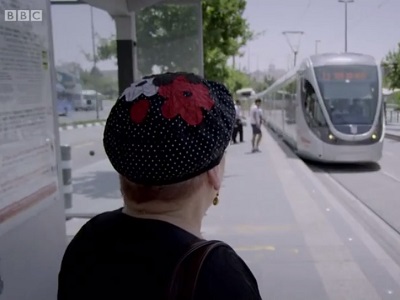
By Or Amit
Google works in mysterious ways. You search for something, you find something else instead, and that something leads to something else still, until you’ve forgotten what you were looking for in the first place.
Recently I searched Google for something relating to Noam Chomsky and found a website that mentions Chomsky’s appearance in the 2015 documentary film The Divide. That movie piqued my interest and I searched for it on various torrent sites. Alas, I wasn’t able to find it, but one of my searches returned something else: a BBC documentary titled The Train that Divides Jerusalem.
Another Google search revealed the movie had elicited the standard knee-jerk bellyaching from the usual suspects, so I decided to give it a chance. It turned out to be quite good and I recommend it to anyone reading these lines.
The film uses Jerusalem’s new light rail line as a framing device for the story of Israel’s occupation and “Judaization” of East Jerusalem. Producer-reporter Adam Wishart takes a trip on the train’s nine-mile route and stops on the way to study the division lines, both physical and psychological, of this ancient city.
Whether serendipitously or intentionally, Wishart stumbled upon a simple truth: to expose the evils of the occupation and of the people behind it, you don’t necessarily have to use photos of dead Palestinian children or footage of destroyed homes and crying mothers.
Another, simpler method consists of shoving a microphone into the faces of Zionist zealots and occupation apologists and allowing them speak freely about their goals and convictions. If the microphone is mightier than the sword, let scoundrels impale themselves upon it.
It works artfully. Wishart begins by following Aryeh King, a man whose raison d’être is the “Judaization of Jerusalem” and Rivka Shimon, who campaigns for the construction of the Third Temple, a messianic pipe dream that is slowly percolating into Israel’s mainstream. The two fanatics are almost funny, and if their activism hadn’t had flesh-and-blood victims, the two could have made for an entertaining reality television duo.
Lest he be accused of drawing a caricature of the human face of oppression by cherry-picking token nuts, Wishart goes all the way to the top of the occupation pyramid and interviews Nir Barkat, Jerusalem’s Likudnik mayor.
After taking us through a journey through the Shuafat refugee camp, an East Jerusalem neighborhood that can best be described as a giant dumpster housing hapless human occupants, and juxtaposing its filth and poverty with the lush elegance of Jewish neighborhoods on the other side of the separation wall, Wishart asks Barkat to comment on Shuafat’s neglect. True to the spirit of Israeli right-wing humanitarianism, Barkat responds:
“You know, I want to share something with you when you talk about refugees. There are no Jewish refugees in the world. Not one. If we find them, we bring them and take them home, and help them. It’s very unfortunate that there are Arab refugees, that with all the wealth of the Arab world, they haven’t found the time and the capital to help the refugees out. The world has to understand that you can throw a few billions of dollars to the problem and find them good homes, not on the account of Israel.”
That answer astounds Wishart, but Barkat deserves praise for being able to stuff so much obtuseness, deflection, and thinly-veiled bigotry into one short paragraph. The man’s glib callousness is Netanyahu-esque.
Later in the film Barkat is asked about the settlement of Pisgat Ze’ev, which was built on confiscated Palestinian lands right across from Shuafat. Barkat decides to go with a standard narrative of eliminative Zionism:
“I don’t get it. In all those places, there was never a Palestinian state. Put a shovel in the ground, and you’ll find Jewish roots. So, when people talk about “occupied land”, occupied from whom? It’s all Jewish! “
In Shuafat, Wishart interviews a Palestinian teenager whose hopes and dreams consist of wanting to be a martyr. Here’s a hopeless kid who dreams of death and destruction because all he sees on the other side of that wall is Barkat and his shovel.
Throughout the film, Wishart weaves the stories of Israeli oppression with those of its Palestinian victims.
One Palestinian man whose land was confiscated in order to build the rail says he is not even allowed to build on what little land he has left, because of—you guessed it—security concerns. He got off easy: the parents of sixteen-year-old Mohammed Abu Khdeir cry as they tell Wishart of how their son was kidnapped and burnt alive by Jewish settlers.
In just under thirty minutes, Wishart manages to offer us a panoramic snapshot of the occupation and the settlements, the occupiers and the occupied, the aggressors and the victims, the ever-expanding Jewish Jerusalem and the fast-shrinking Palestinian one. A city of two tales, with a wall and a rail snaking through it.
As the film and the day are winding down, Rivka Shimon, having concluded a long day of Temple tantrums, settles into the verandah of her Pisgat Ze’ev home, scans the picturesque hills surrounding the settlement and waxes philosophical about the serenity and the clean air. Shuafat is visible a few blocks away, its minatory separation wall an eyesore against this idyllic background.
Asked whether she’d ever visited Shuafat, Shimon flashes a coy smile. “No, of course not,” she says. “Even the police don’t go there.”
– Or Amit is a freelance writer living in Dresden, Germany. He contributed this article to PalestineChronicle.com.





